When it comes to your personal finances, few topics generate as much confusion—and anxiety—as taxes. Whether you’re an employee, self-employed, retired, or a business owner in Canada, it’s natural to wonder if you’re managing your income in a way that minimizes your tax burden. A question that frequently comes up—especially around tax season or major financial events—is: “What is the best tax bracket to be in Canada?”
It’s a logical question. On the surface, it may seem like there’s a “sweet spot” for income where you pay the least amount of tax yet still earn a decent living. But understanding Canada’s progressive tax system reveals that the concept of a “best” tax bracket is more nuanced than just aiming to earn less or stay under specific thresholds.
As a Canadian, your income gets taxed at both the federal and provincial/territorial levels. And with multiple income sources—from employment and side hustles to dividends and capital gains—your tax situation can quickly become complex. Add in government benefits like the Canada Child Benefit (CCB), Old Age Security (OAS), and GST/HST credits, which phase out at certain income levels, and things get even trickier. Suddenly, your “effective” tax rate—what you actually pay on your total income—can be very different from your “marginal” tax rate—what you’re taxed on your next dollar of income.
So, what does it really mean to be in a “good” or “bad” tax bracket in Canada? Is staying in a lower bracket always better? Should you avoid raises, bonuses, or extra income to stay in a favorable range? What about retirement or benefits for families?
In this comprehensive article, we’ll answer all those questions, bust common myths, and give you the real tools to evaluate which tax bracket is most beneficial for your situation. You’ll gain:
- A clear understanding of how Canadian tax brackets work
- An in-depth comparison of federal and provincial tax rates
- Insights into marginal vs. effective tax rates
- Practical strategies to optimize your income and reduce your overall tax liability
- A better understanding of clawback zones and how they can affect your net benefits
Whether you’re trying to keep more of your paycheque, plan for retirement, or simply learn how to make smarter decisions about income and taxes, this guide will give you a road map. By the end, you’ll be armed with the knowledge you need to optimize your tax position by understanding not just what tax bracket you’re in now, but which bracket works best for your financial goals.
Let’s dive in and demystify Canada’s tax brackets once and for all.
Understanding Tax Brackets in Canada
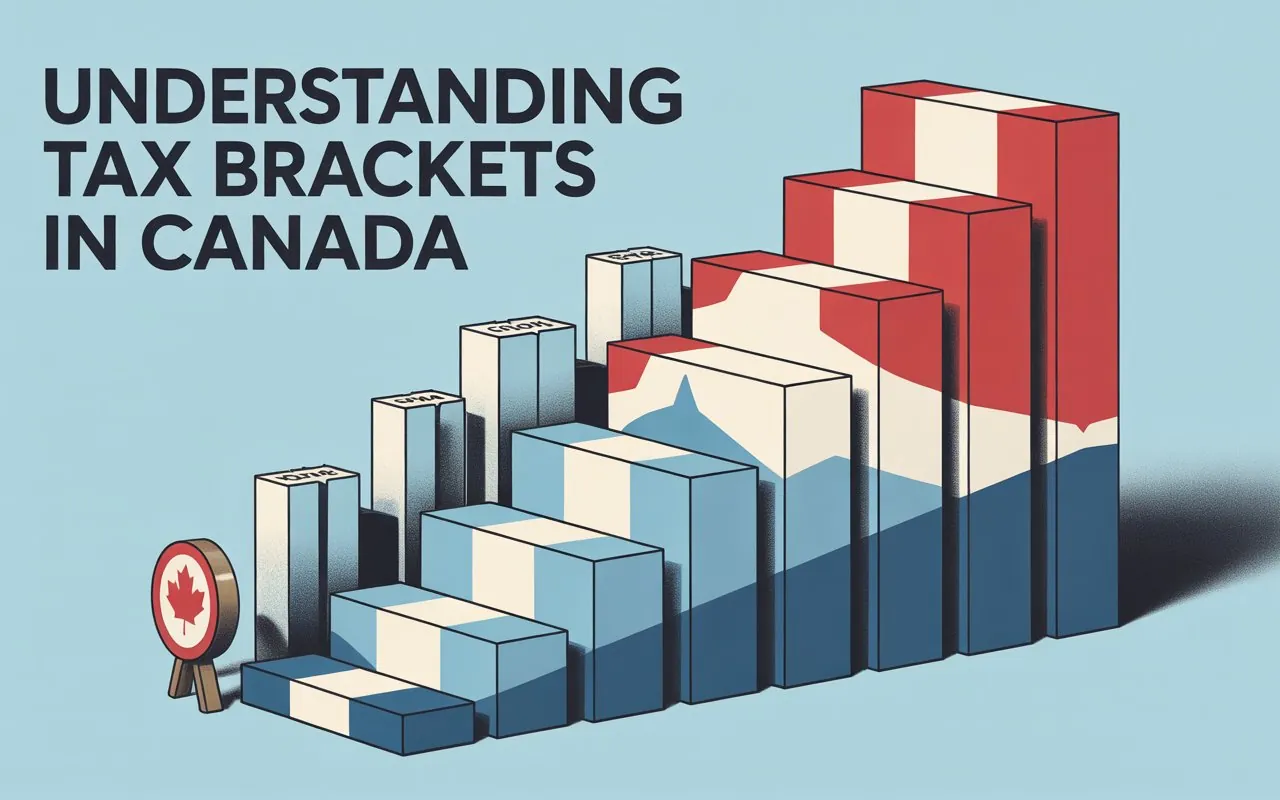
What Is a Tax Bracket?
A tax bracket is a segment of income taxed at a specific rate. Canada uses a progressive tax system—meaning that as your income increases, the rate you pay on each additional dollar does too.
Progressive Taxation in Action
- The first portion of your income is taxed at the lowest rate.
- Each increment above certain thresholds is taxed at a progressively higher rate.
- Your income is split into segments—each with its own rate.
Example
If you earn $80,000, part of that income is taxed at 15%, the next portion at 20.5%, and so on. The key is you never pay a single rate on your entire income.
Common Myths Debunked
- Myth: Entering a new bracket means all your income is taxed at the higher rate.
- Fact: “Bracket creep” is a myth—only the portion above the threshold is taxed at the higher rate.
Marginal vs. Effective Tax Rates
- Marginal Rate: Tax paid on your next dollar of income.
- Effective Rate: Average rate paid on all your taxable income.
Why This Matters
Knowing your marginal rate helps you assess if a raise, bonus, or investment income is worthwhile after accounting for taxes. Your effective rate shows your total tax burden.
Deep Example: Comparing Marginal and Effective Tax Rates
Suppose Anna earns $120,000. Here’s how her federal tax looks:
- First $55,867 × 15% = $8,380
- Next $55,866 × 20.5% = $11,450
- Remaining $8,267 × 26% = $2,149.42
Total Federal Tax: $21,979.42
Effective Federal Rate: $21,979.42 ÷ $120,000 ≈ 18.3%
Marginal Rate (above $111,733): 26%
Federal Tax Brackets: Detailed 2025 Analysis
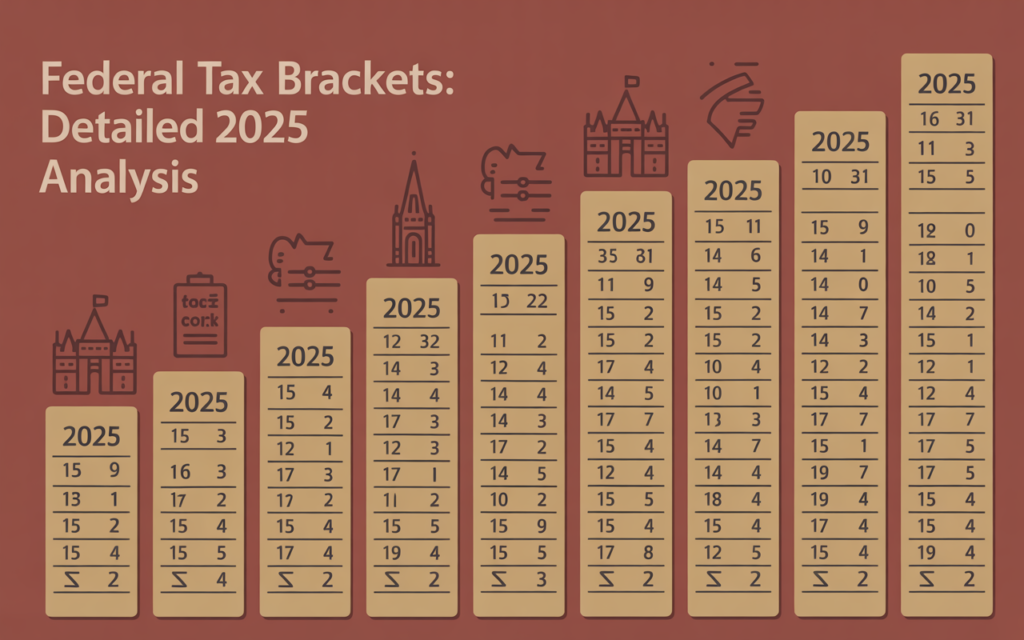
Federal Tax Rates and Ranges (2025)
| 2025 Federal Income Range | Federal Tax Rate |
|---|---|
| Up to $55,867 | 15% |
| $55,868 to $111,733 | 20.5% |
| $111,734 to $173,205 | 26% |
| $173,206 to $246,752 | 29% |
| Over $246,752 | 33% |
How Federal Brackets Are Indexed
Each year, tax brackets are adjusted for inflation—a process called indexation. This helps prevent so-called “bracket creep” where inflation alone pushes taxpayers into higher rates.
Calculation Example: $200,000 Salary
- First $55,867 × 15% = $8,380.05
- Next $55,866 × 20.5% = $11,449.53
- Next $61,472 × 26% = $15,983
- Next $73,547 × 29% = $21,329
- Remaining ($200,000 – $246,752 = N/A), so no income in 33% bracket
Total Federal Tax: $8,380.05 + $11,449.53 + $15,983 + $21,329 = $57,141.58
Effective Rate: $57,141.58 ÷ $200,000 ≈ 28.6%
Impact of Federal Surtaxes
Canada doesn’t use a formal federal surtax, but some provinces do. Always check both levels when planning.
Provincial and Territorial Tax Brackets: Regional Comparisons
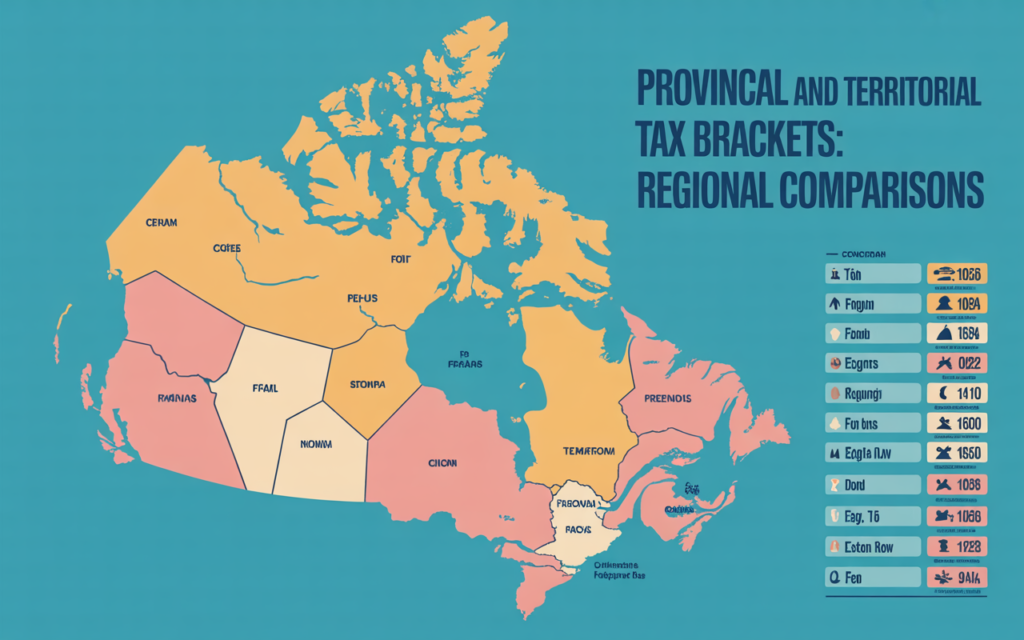
Each province/territory sets its own tax brackets. Let’s compare major regions and highlight why provincial rates matter:
| Province/Territory | Lowest Rate (%) | Highest Rate (%) | Number of Brackets | Highest Rate Starts At |
|---|---|---|---|---|
| Ontario | 5.05 | 20.53 | 5 | $240,726 |
| British Columbia | 5.06 | 20.5 | 7 | $240,716 |
| Alberta | 10.00 | 15.00 | 5 | $322,171 |
| Quebec | 15.00 | 25.75 | 4 | $119,910 |
| Nova Scotia | 8.79 | 21.00 | 5 | $150,000 |
Why Provincial Tax Matters for Your Bottom Line
- Higher incomes are taxed differently in, say, Quebec (higher rates) vs. Alberta (lower rates).
- Credits and tax benefits (medical, education, family) vary. Quebec offers rich family credits; Alberta’s top rate kicks in at a higher threshold.
Cross-Province Example
Two people earning $90,000—one in Alberta, one in Quebec—will pay markedly different total taxes due to provincial rates, credits, and surcharges.
Myths and Realities About Canadian Tax Brackets
Myth: Climbing a Bracket Hurts Your Pay
Fact: Your take-home always rises with higher income; only the “slice” above a threshold gets taxed at that higher rate.
Myth: There’s One Ideal Bracket for All
What is “best” depends on many factors:
- Your province
- Family status (e.g., dependents)
- Age (pensioners have unique credits)
- Type and source of income (salary, dividends, capital gains are taxed differently)
Reality: Effective Tax Planning Is Personalized
For some, avoiding the OAS clawback zone is crucial; for others, optimizing net pay is about maximizing family benefits or planning for retirement.
Marginal vs. Effective Tax Rate: In-Depth Calculations
Marginal Tax Rate: The Key for Decisions
If you’re offered a $10,000 raise, your marginal tax rate on that sum could total over 50% (federal + provincial, after certain thresholds), especially in top brackets in Ontario or Quebec.
Marginal Rate Table (Sample, Ontario, 2025)
| Income Range | Marginal Federal | Marginal Provincial | Combined Marginal |
|---|---|---|---|
| $50,000–$100,000 | 20.5% | 9.15% | 29.65% |
| $150,000–$200,000 | 26% | 12.16% | 38.16% |
| > $240,000 | 33% | 20.53% | 53.53% |
Actionable Tax Strategies: Staying in the Most Effective Bracket
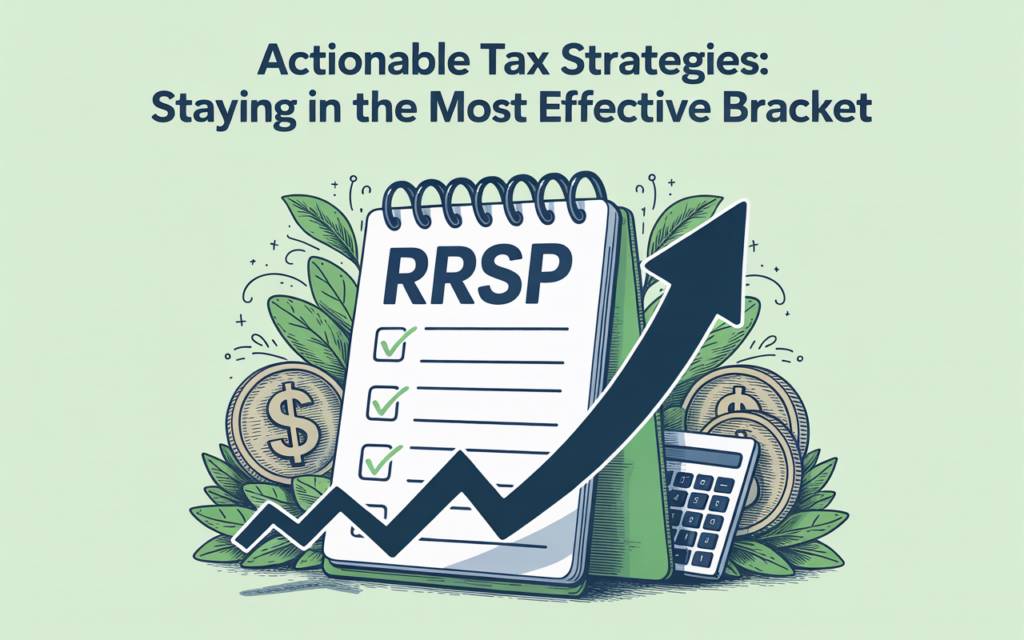
Maximize Deductions
- RRSP Contributions: Lower your taxable income, possibly putting you in a lower bracket.
- Child Care Expenses: Claim up to $8,000 per child under 7.
- Moving Expenses: Moving at least 40 km closer to work? Many expenses can be deducted.
Income Splitting
- Spousal RRSPs: Contribute to a lower-earning spouse’s RRSP, reducing family taxes.
- Pension Splitting: Share up to 50% of eligible pension with a spouse or common-law partner—can move income to a lower bracket.
Defer or Advance Income
- Bonuses: Delay a bonus until a lower-income year, if possible.
- Capital Gains: Realize gains in a retirement year for a lower bracket, or spread gains over several years.
Leverage Tax Credits
- Basic Personal Amount ($15,705 federally for 2025): Reduces taxes for all.
- Canada Employment Amount: Up to $1,368 in 2025.
- Disability, Tuition, Medical Credits: Can be transferred or carried forward.
Provincial Planning
Tax rates and credits vary widely:
- Quebec: Family and education credits are substantial.
- BC/Ontario: Rich medical and low-income credits; check for provincial child benefits.
Government Benefits and Clawbacks
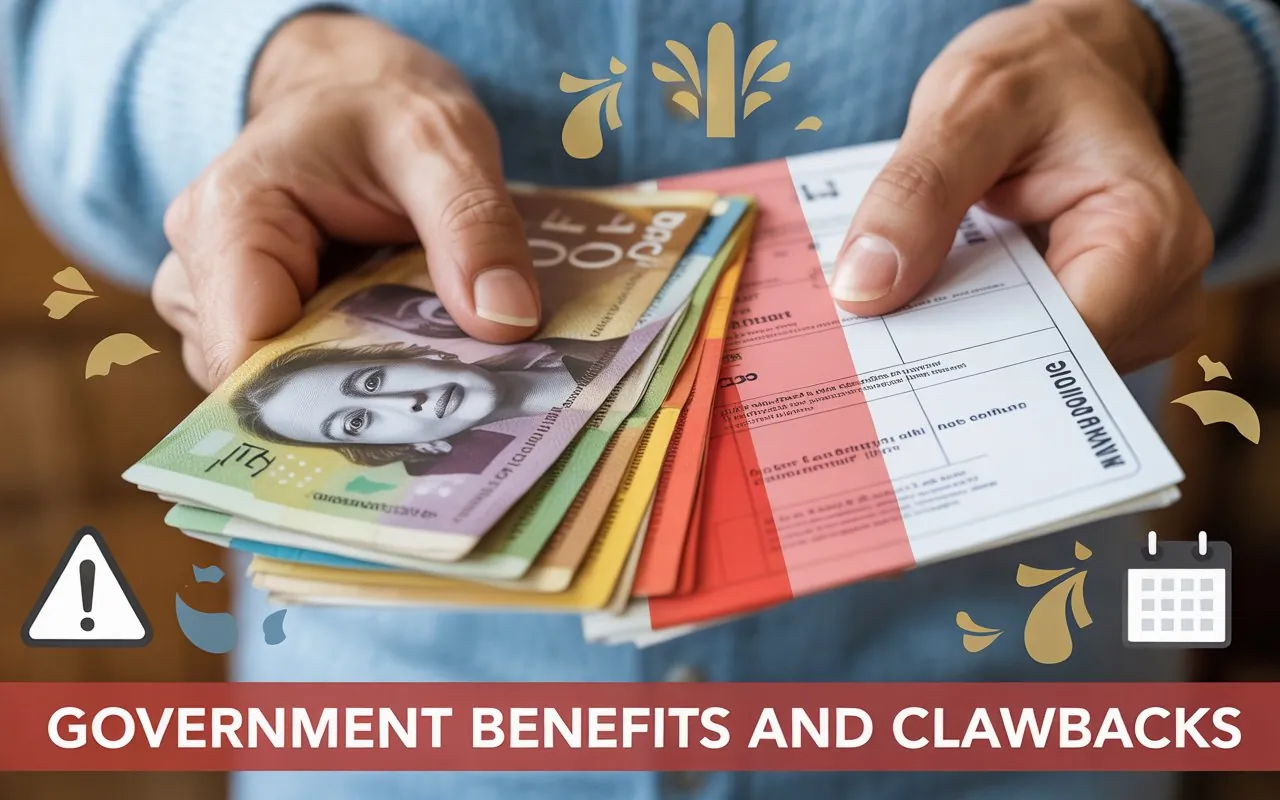
Clawbacks: Understanding Danger Zones
When your income crosses certain thresholds, you don’t just face tax, but also lose benefits, creating “clawback zones” where the effective tax rate can soar.
Canada Child Benefit (CCB)
- Begins clawing back at ~ $32,000 family net income; rates accelerate above $72,000.
GST/HST Credit
- Phased out for individuals over ~$50,000; families at higher numbers.
Old Age Security (OAS)
- OAS “repayment” starts at $91,000 (2025); every dollar over this triggers a 15% clawback.
Example of High Marginal Effective Tax Rate
Suppose a senior is at $91,000 net income:
- Next $1,000 is taxed at marginal rate (say, 33%)
- Plus $150 OAS clawback (15% of $1,000)
- Effective marginal rate: 48%
Avoiding Clawback Zones
- Strategize withdrawals (RRSP, RRIF) to stay below cliffs.
- Defer CPP/OAS to lower-income years.
Deciding the Best Tax Bracket for You: Personal Factors
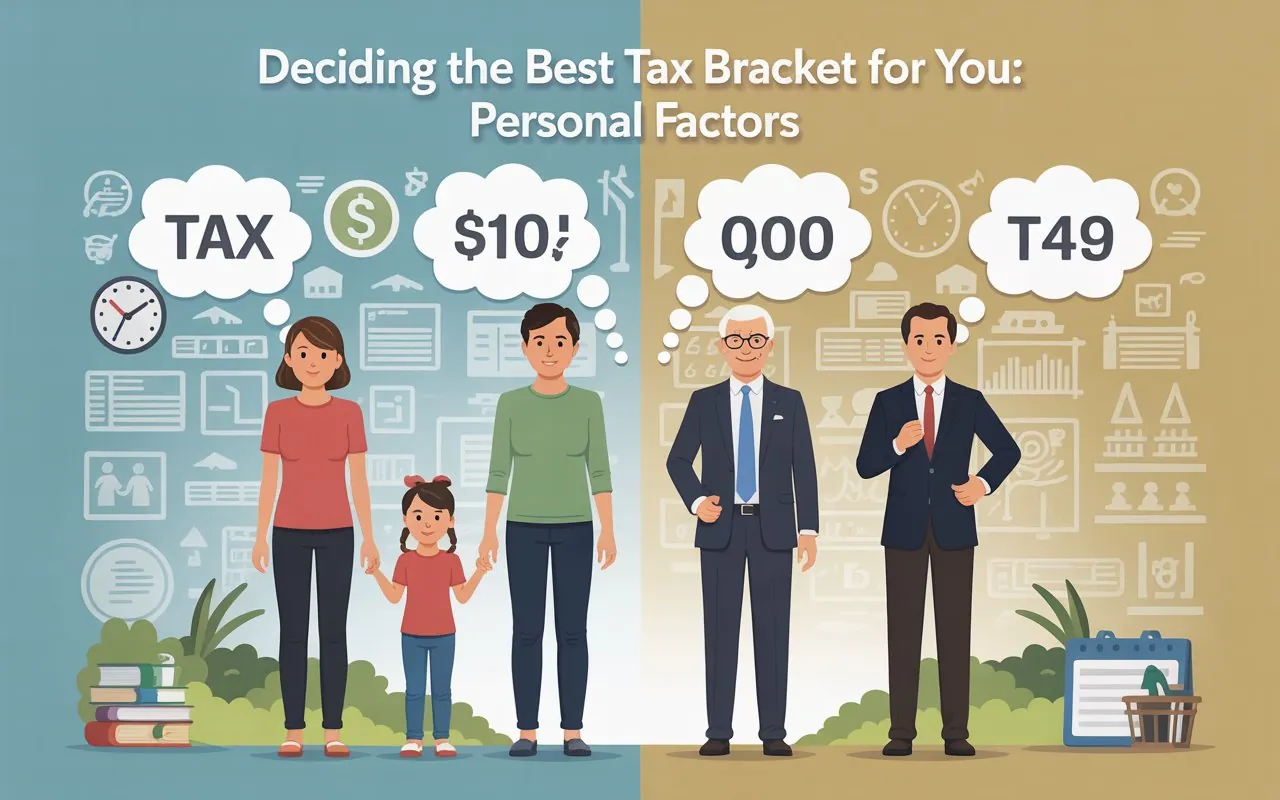
Assessing Your Ideal Bracket
No universal “best” bracket exists. Consider:
- Family Size and Status: Families with children or dependent adults may benefit most from maximizing credits and benefits, not just minimizing taxes.
- Employment Type: Salaried, self-employed, contractor, or business owner—each category offers unique deductions.
- Retirement Timeline: Near-retirees should plan RRSP/RRIF withdrawals to optimize OAS and avoid high tax years.
- Type of Income: Salary, capital gains, Canadian dividends—all are taxed differently. Capital gains, for example, are taxed on only 50% of the gain.
Advanced Planning: Practical Scenarios and Case Studies
Case 1: High-Income Professional in Alberta
Alberta’s top rate doesn’t kick in until over $322,000. A professional earning $250,000 has more room at lower rates compared to Quebec, making Alberta attractive for those with very high earnings.
Case 2: Family With Children in Ontario
By planning salary, bonus, and RRSP contributions to keep net family income below key CCB phase-out levels, a family can maximize both credits and benefits—streamlining both tax and government support.
Case 3: Approaching Retirement
A retiree with RRSPs and pensions should carefully plan withdrawals to:
- Avoid OAS clawbacks
- Use pension income splitting
- Defer CPP/OAS until a lower-income year
Case 4: Self-Employed Freelancer
Freelancers can:
- Deduct eligible business expenses, lowering net taxable income
- Use income averaging, if available, to minimize tax spikes from extraordinary years
Practical Tips for All Scenarios
- Use online tax calculators to model different incomes and deductions
- Keep meticulous records for all deductions and credits
- Consult a qualified tax professional for tailored advice
Action Steps:
- Review your past year’s tax return to determine your effective and marginal rates.
- Model next year’s tax scenarios using calculators for your province.
- Develop a plan to maximize contributions (RRSP, TFSA) and strategic withdrawals.
- Check income thresholds for all relevant benefits/credits.
- Schedule annual reviews with a tax professional to keep up with changing rules.
Frequently Asked Questions

Will Earning More Push Me Into a Higher Tax Bracket and Reduce My Net Income?
No. Only income above each threshold is taxed at the higher rate. Each extra dollar earned always nets you more after tax.
How Can I Make the Most of My Tax Bracket in Canada?
Maximize deductions (RRSP, childcare, moving expenses), take advantage of all tax credits offered, and manage your income strategically with tools like income splitting and timing of large payments.
Can My Marginal Rate Exceed 50%?
Yes, in certain provinces and at high-income levels, your combined federal and provincial rate (plus benefit clawbacks) can push the effective marginal tax rate over 50%. Planning is key to mitigating the impact.
Where Can I Find Tools to Calculate My Taxes?
The Canada Revenue Agency and most provincial finance departments offer online calculators for current tax year rates.
Conclusion
Choosing the “best tax bracket to be in Canada” depends on your unique circumstances. Smart tax planning involves: Understanding both marginal and effective tax rates, Factoring in benefit thresholds and clawback zones ,Leveraging every available deduction, credit, and income-splitting opportunity, Seeking personalized advice from a certified professional